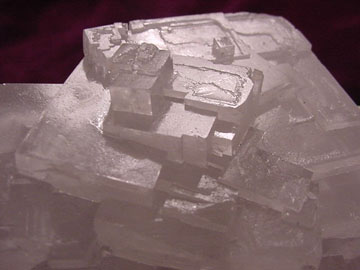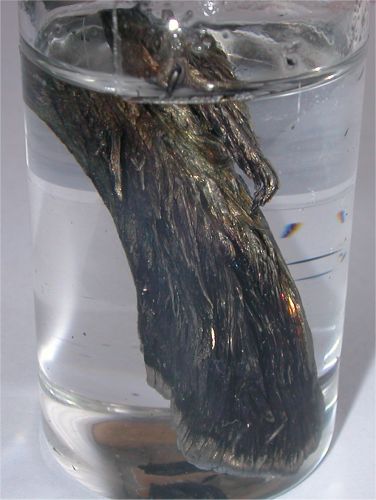|
Frankdicksonite
Frankdicksonite is a halide mineral with the chemical formula Ba F2 which corresponds to the chemical compound barium fluoride. It occurs in the Carlin gold deposit of Eureka County, Nevada as cubic crystals sized between 0.1 and 4 mm, and is of hydrothermal origin. Its only associated mineral is quartz and the frankdicksonite crystals are always completely encapsulated in it. Frankdicksonite has fluorite crystal structure with a cubic symmetry and the lattice constant ''a'' = 619.64 pm. Its Vickers hardness on the cleavage crystal faces varies between 88 and 94 kg/mm2 and is close to that of the synthetic barium fluoride (95 kg/mm2). Its refractive index (1.475) is almost identical to that of BaF2 (1.474). Under electron irradiation, it emits strong blue cathodoluminescence. The major impurity in frankdicksonite is strontium with concentrations up to 0.5% by weight. Also present are silicon (0.02%) and magnesium (0.0015%); other impurities have concentrations below ... [...More Info...] [...Related Items...] OR: [Wikipedia] [Google] [Baidu] |
Halide Mineral
Halide minerals are those minerals with a dominant halide anion (, , and ). Complex halide minerals may also have polyatomic anions. Examples include the following: *Atacamite * Avogadrite (K,Cs)BF *Bararite (β) *Bischofite * Brüggenite *Calomel *Carnallite *Carnallite * Cerargyrite/Horn silver AgCl * Chlorargyrite AgCl, bromargyrite AgBr, and iodargyrite AgI *Cryolite *Cryptohalite (a) Vanadates), 09 Silicates: * ''neso-'': insular (from Greek , "island") * ''soro-'': grouped (from Greek , "heap, pile, mound") * ''cyclo-'': ringed (from Greek , "circle") * ''ino-'': chained (from Greek , "fibre", rom Ancient Greek * ''phyllo-'': sheeted (from Greek , "leaf") * ''tecto-'': of three-dimensional framework (from Greek , "of building") ;Nickel–Strunz code scheme ''NN.XY.##x'': * ''NN'': Nickel–Strunz mineral class number * ''X'': Nickel–Strunz mineral division letter * ''Y'': Nickel–Strunz mineral family letter * ''##x'': Nickel–Strunz mineral/group n ... [...More Info...] [...Related Items...] OR: [Wikipedia] [Google] [Baidu] |
Halide Mineral
Halide minerals are those minerals with a dominant halide anion (, , and ). Complex halide minerals may also have polyatomic anions. Examples include the following: *Atacamite * Avogadrite (K,Cs)BF *Bararite (β) *Bischofite * Brüggenite *Calomel *Carnallite *Carnallite * Cerargyrite/Horn silver AgCl * Chlorargyrite AgCl, bromargyrite AgBr, and iodargyrite AgI *Cryolite *Cryptohalite (a) Vanadates), 09 Silicates: * ''neso-'': insular (from Greek , "island") * ''soro-'': grouped (from Greek , "heap, pile, mound") * ''cyclo-'': ringed (from Greek , "circle") * ''ino-'': chained (from Greek , "fibre", rom Ancient Greek * ''phyllo-'': sheeted (from Greek , "leaf") * ''tecto-'': of three-dimensional framework (from Greek , "of building") ;Nickel–Strunz code scheme ''NN.XY.##x'': * ''NN'': Nickel–Strunz mineral class number * ''X'': Nickel–Strunz mineral division letter * ''Y'': Nickel–Strunz mineral family letter * ''##x'': Nickel–Strunz mineral/group n ... [...More Info...] [...Related Items...] OR: [Wikipedia] [Google] [Baidu] |
Barium Fluoride
Barium fluoride (BaF2) is an inorganic compound with the formula BaF2. It is a colorless solid that occurs in nature as the rare mineral frankdicksonite. Under standard conditions it adopts the fluorite structure and at high pressure the PbCl2 structure. Like CaF2, it is resilient to and insoluble in water. Above ca. 500 °C, BaF2 is corroded by moisture, but in dry environments it can be used up to 800 °C. Prolonged exposure to moisture degrades transmission in the vacuum UV range. It is less resistant to water than calcium fluoride, but it is the most resistant of all the optical fluorides to high-energy radiation, though its far ultraviolet transmittance is lower than that of the other fluorides. It is quite hard, very sensitive to thermal shock and fractures quite easily. Optical properties Barium fluoride is transparent from the ultraviolet to the infrared, from 150 to 200 nm to 11–11.5 µm. It is used in windows for infrared spectroscopy, in particular i ... [...More Info...] [...Related Items...] OR: [Wikipedia] [Google] [Baidu] |
Michael Fleischer (mineralogist)
Michael Fleischer ( 27 February 1908 – 5 September 1998) was an American chemist and mineralogist. He worked as a geochemist with the U.S. Geological Survey from 1939 to 1978. He published a huge number of chemical abstracts and reviews of proposed mineral names, and is known for his authoritative ''Glossary of Mineral Species'', first published in 1971. Early years (1908–39) Michael Fleischer was born on 27 February 1908 in Bridgeport, Connecticut, the son of Hungarian Jewish immigrants. He studied chemistry and mineralogy at Yale University from 1927 to 1933. He obtained a Bachelor of Science degree magna cum laude in 1930 and a doctorate in physics in 1933. He graduated during the Great Depression. His first job was a chemist in a toothpaste factory. He married Helen Isenberg and they had two sons, Walter and David. From 1933 to 1934 Fleischer was a research associate at Yale's Department of Chemistry. From 1934 to 1936 he was an assistant to Professor William Ebenezer For ... [...More Info...] [...Related Items...] OR: [Wikipedia] [Google] [Baidu] |
Strontium
Strontium is the chemical element with the symbol Sr and atomic number 38. An alkaline earth metal, strontium is a soft silver-white yellowish metallic element that is highly chemically reactive. The metal forms a dark oxide layer when it is exposed to air. Strontium has physical and chemical properties similar to those of its two vertical neighbors in the periodic table, calcium and barium. It occurs naturally mainly in the minerals celestine and strontianite, and is mostly mined from these. Both strontium and strontianite are named after Strontian, a village in Scotland near which the mineral was discovered in 1790 by Adair Crawford and William Cruickshank; it was identified as a new element the next year from its crimson-red flame test color. Strontium was first isolated as a metal in 1808 by Humphry Davy using the then newly discovered process of electrolysis. During the 19th century, strontium was mostly used in the production of sugar from sugar beets (see strontian p ... [...More Info...] [...Related Items...] OR: [Wikipedia] [Google] [Baidu] |
Fluorine Minerals
Fluorine is a chemical element with the symbol F and atomic number 9. It is the lightest halogen and exists at standard conditions as a highly toxic, pale yellow diatomic gas. As the most electronegative reactive element, it is extremely reactive, as it reacts with all other elements except for the light inert gases. Among the elements, fluorine ranks 24th in universal abundance and 13th in terrestrial abundance. Fluorite, the primary mineral source of fluorine which gave the element its name, was first described in 1529; as it was added to metal ores to lower their melting points for smelting, the Latin verb meaning 'flow' gave the mineral its name. Proposed as an element in 1810, fluorine proved difficult and dangerous to separate from its compounds, and several early experimenters died or sustained injuries from their attempts. Only in 1886 did French chemist Henri Moissan isolate elemental fluorine using low-temperature electrolysis, a process still employed for modern produc ... [...More Info...] [...Related Items...] OR: [Wikipedia] [Google] [Baidu] |
Barium Minerals
Barium is a chemical element with the symbol Ba and atomic number 56. It is the fifth element in group 2 and is a soft, silvery alkaline earth metal. Because of its high chemical reactivity, barium is never found in nature as a free element. The most common minerals of barium are baryte (barium sulfate, BaSO4) and witherite (barium carbonate, BaCO3). The name ''barium'' originates from the alchemical derivative "baryta", from Greek (), meaning 'heavy'. ''Baric'' is the adjectival form of barium. Barium was identified as a new element in 1774, but not reduced to a metal until 1808 with the advent of electrolysis. Barium has few industrial applications. Historically, it was used as a getter for vacuum tubes and in oxide form as the emissive coating on indirectly heated cathodes. It is a component of YBCO (high-temperature superconductors) and electroceramics, and is added to steel and cast iron to reduce the size of carbon grains within the microstructure. Barium compounds are ad ... [...More Info...] [...Related Items...] OR: [Wikipedia] [Google] [Baidu] |
Mineralogy
Mineralogy is a subject of geology specializing in the scientific study of the chemistry, crystal structure, and physical (including optical) properties of minerals and mineralized artifacts. Specific studies within mineralogy include the processes of mineral origin and formation, classification of minerals, their geographical distribution, as well as their utilization. History Early writing on mineralogy, especially on gemstones, comes from ancient Babylonia, the ancient Greco-Roman world, ancient and medieval China, and Sanskrit texts from ancient India and the ancient Islamic world. Books on the subject included the ''Naturalis Historia'' of Pliny the Elder, which not only described many different minerals but also explained many of their properties, and Kitab al Jawahir (Book of Precious Stones) by Persian scientist Al-Biruni. The German Renaissance specialist Georgius Agricola wrote works such as '' De re metallica'' (''On Metals'', 1556) and ''De Natura Fossilium'' ( ... [...More Info...] [...Related Items...] OR: [Wikipedia] [Google] [Baidu] |
Stanford University
Stanford University, officially Leland Stanford Junior University, is a private research university in Stanford, California. The campus occupies , among the largest in the United States, and enrolls over 17,000 students. Stanford is considered among the most prestigious universities in the world. Stanford was founded in 1885 by Leland and Jane Stanford in memory of their only child, Leland Stanford Jr., who had died of typhoid fever at age 15 the previous year. Leland Stanford was a U.S. senator and former governor of California who made his fortune as a railroad tycoon. The school admitted its first students on October 1, 1891, as a coeducational and non-denominational institution. Stanford University struggled financially after the death of Leland Stanford in 1893 and again after much of the campus was damaged by the 1906 San Francisco earthquake. Following World War II, provost of Stanford Frederick Terman inspired and supported faculty and graduates' entrepreneu ... [...More Info...] [...Related Items...] OR: [Wikipedia] [Google] [Baidu] |
Geochemistry
Geochemistry is the science that uses the tools and principles of chemistry to explain the mechanisms behind major geological systems such as the Earth's crust and its oceans. The realm of geochemistry extends beyond the Earth, encompassing the entire Solar System, and has made important contributions to the understanding of a number of processes including mantle convection, the formation of planets and the origins of granite and basalt. It is an integrated field of chemistry and geology. History The term ''geochemistry'' was first used by the Swiss-German chemist Christian Friedrich Schönbein in 1838: "a comparative geochemistry ought to be launched, before geognosy can become geology, and before the mystery of the genesis of our planets and their inorganic matter may be revealed." However, for the rest of the century the more common term was "chemical geology", and there was little contact between geologists and chemists. Geochemistry emerged as a separate discipline after ... [...More Info...] [...Related Items...] OR: [Wikipedia] [Google] [Baidu] |
Frank W
Frank or Franks may refer to: People * Frank (given name) * Frank (surname) * Franks (surname) * Franks, a medieval Germanic people * Frank, a term in the Muslim world for all western Europeans, particularly during the Crusades - see Farang Currency * Liechtenstein franc or frank, the currency of Liechtenstein since 1920 * Swiss franc or frank, the currency of Switzerland since 1850 * Westphalian frank, currency of the Kingdom of Westphalia between 1808 and 1813 * The currencies of the German-speaking cantons of Switzerland (1803–1814): ** Appenzell frank ** Aargau frank, Argovia frank ** Basel frank ** Berne frank ** Fribourg frank ** Glarus frank ** Graubünden frank ** Luzern frank ** Schaffhausen frank ** Schwyz frank ** Solothurn frank ** St. Gallen frank ** Thurgau frank ** Unterwalden frank ** Uri frank ** Zürich frank Places * Frank, Alberta, Canada, an urban community, formerly a village * Franks, Illinois, United States, an unincorporated community * Franks, Missouri ... [...More Info...] [...Related Items...] OR: [Wikipedia] [Google] [Baidu] |
Magnesium
Magnesium is a chemical element with the symbol Mg and atomic number 12. It is a shiny gray metal having a low density, low melting point and high chemical reactivity. Like the other alkaline earth metals (group 2 of the periodic table) it occurs naturally only in combination with other elements and it almost always has an oxidation state of +2. It reacts readily with air to form a thin passivation coating of magnesium oxide that inhibits further corrosion of the metal. The free metal burns with a brilliant-white light. The metal is obtained mainly by electrolysis of magnesium salts obtained from brine. It is less dense than aluminium and is used primarily as a component in strong and lightweight alloys that contain aluminium. In the cosmos, magnesium is produced in large, aging stars by the sequential addition of three helium nuclei to a carbon nucleus. When such stars explode as supernovas, much of the magnesium is expelled into the interstellar medium where it ma ... [...More Info...] [...Related Items...] OR: [Wikipedia] [Google] [Baidu] |







